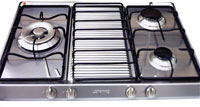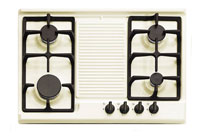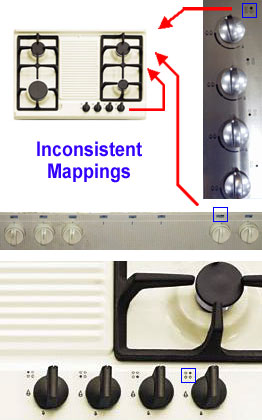|
The stovetop design in Fig.
1 is quite peculiar. There are three burners and four
identical control knobs. Embedded into the stove top are mapping lines
which help users figure out the mapping of the two right burners, but
the main left burner is a bit of a mystery. In this design, the
associations in WM are weakened by odd mappings and two controls for
one burner (some users with a strong goal-oriented focus on the
control knobs, might not even see the mapping lines, especially in a
dim or brightly lit room with no shadows).
The stovetop design in Fig.
2 uses diagrams above the controls to help users determine
mapping. The problem is users have to step back and crouch down to
look at these mappings. Most users will not do this because it is
easier to just turn a knob (you have a 50/50 chance). A dirty stove
will also present problems.

Furthermore, the third knob from
the left which operates the oven is identical to the other knobs which
operate the burners. Although the largest burner on the lower left is
easily mapped to the first control, invariably the two right burners
are difficult to figure out. Three decorative mappings in the middle
of the control panel further confuse users increasing load to working
memory.
The stovetop design in Fig.
2 could be improved by moving the oven control to the
middle, and by using slightly smaller knobs for the controls that map
to the two small burners top-left and bottom-right.

The stovetop designs in Fig.
2, Fig. 3, and Fig.
4, might explain the increasing popularity of conceptually
simpler three burner designs. Four burner stovetops are frequently
poorly designed. Strangely enough, each of the stovetops have different mappings for the two right
burners (see Fig. 5). Four burner stovetops are notorious for variations in burner
mappings; survey your local appliance store and find out for yourself. The chances of accidentally leaving a burner on are higher
than design that facilitates the retention of an accurate conceptual
model that can be easily sketched from memory.
|
Fig. 1. A Three Burner Stove With
Four Identical Control Knobs

Fig. 2. Four Burner Stovetop With Mappings
That Are Difficult to Make Out

Fig. 3. Four Burner Stovetop With
More Common Mappings

Fig. 4. Four Burner Stovetop With
Unconventional Mappings

Fig. 5. Different Mappings for the
Two Right Burners (see Fig. 2, 3, and 4)

|